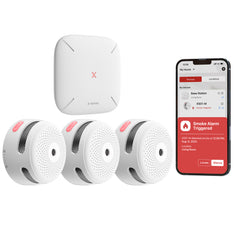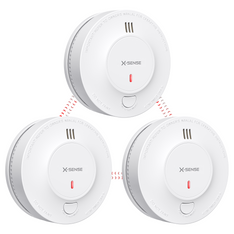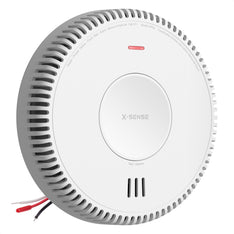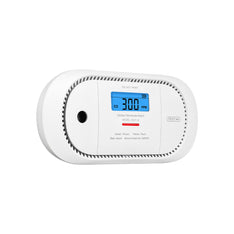Top Fire Prevention Safety Tips That You Should Know
Fri, Jul 24, 2020
According to data from fire-safety research organizations, fire departments in the United States respond to an average of one residential fire every 90 seconds. This demonstrates that house fires remain a major threat to the safety of homes and property in the United States. The good news is that most house fires are preventable. By understanding basic fire prevention safety tips, developing a comprehensive plan, and utilizing modern fire detection technology effectively, you can significantly reduce the risk of a fire in your home and be better prepared to respond quickly in case of an emergency.
What Does Fire Safety and Prevention Mean?
Safety and fire prevention refers to taking proactive measures to prevent fires, such as identifying potential fire hazards, reducing fire risks, and installing reliable fire alarm systems. These are all part of routine fire safety and prevention practices, primarily the responsibility of households and property owners. However, effective prevention requires every family member to pay attention to the small details and implement these measures in their daily lives, such as practicing safe cooking habits, storing flammable materials properly, ensuring that fire alarms are functioning correctly, and developing and practicing escape routes. These measures can significantly reduce the likelihood of minor incidents escalating into major disasters.
Important Rules and Knowledge for Fire Prevention
Understanding the core rules and concepts helps turn tips into consistent behavior.
1. What are the 5 basic rules of fire safety?
The 5 basic fire safety rules are:
- Keep away from open flames; store flammable materials safely, such as candle.
- Regularly check electrical wiring and appliances to ensure safety.
- Keep a fire extinguisher in your home and ensure it is always functional.
- Develop and practice an escape plan.
- Install smoke detectors and test them regularly.

2. What are the "4Ps" of fire safety?
The "4Ps" refer to people, property, prevention, and planning. When a fire occurs, prioritize the safety of people, then property; focus on prevention, and have an emergency plan in place.
3. What are the 7 levels of fire safety?
Fire safety typically includes 7 levels: Prevention, Detection, Suppression, Evacuation, Compartmentation, Structural Protection, Emergency Response. Multi-layered protection measures effectively reduce fire risks.
4. What is the golden rule of fire safety?
The golden rule of fire safety is "Get out, stay out, and call for help". Never re-enter a burning building; remember: life comes first.
5. What is the basic principle of fire safety?
The basic principle is to eliminate fire hazards. This includes safely storing flammable materials, regularly maintaining equipment, and developing good safety habits.
6. What does "BEEP" mean in fire safety?
"BEEP" stands for Battery, Evacuation, Exit, and Plan. Specifically, it means checking the batteries in smoke detectors, preparing for evacuation, knowing the escape routes, and regularly practicing emergency procedures.
7. What is the "triangle" principle of fire?
The "triangle" principle of fire is heat source, fuel, and oxygen. If any one of these elements is missing, fire cannot burn or spread.
Everyday Safety Tips for Fire Prevention
The key to fire prevention lies in developing good daily habits. Even small, everyday habits can make a positive difference in fire safety prevention. By strictly implementing the following fire safety measures in your daily life, you can significantly reduce the risk of a home fire.
1. Kitchen Safety
Never leave the kitchen unattended while cooking; use a timer to prevent food from overheating or burning; keep pot handles facing inward to avoid accidental spills and fires. During holidays, such as Thanksgiving, increased use of cooking appliances and open flames can raise the risk of fire, so extra caution is necessary.
2. Heater and Winter Electrical Safety
Heaters are a leading cause of residential fires during winter. When using a heater, keep it at least 3 feet (approximately 1 meter) away from any flammable materials; unplug it when not in use.
3. Candle and Open Flame Safety
For safety, use flameless candles whenever possible; if using real candles, place them on a stable, non-combustible surface and extinguish them before going to sleep or leaving the room.
4. Device Charging and Usage Safety
Do not charge devices under pillows or on beds; replace any damaged power cords immediately.
5. Child Safety
Keep matches, lighters, and other flammable items out of children's reach; educate children about the dangers of fire.

6. Wildfire and Outdoor Safety
In high-risk wildfire areas, maintain a safe distance from potential fire hazards and follow local fire safety guidelines during wildfire season.
Organizational Measures for Safety and Fire Prevention
Only with thorough preparation can we remain calm and respond effectively in the event of a fire. Here are some highly recommended preparedness measures and training:
1. Evacuation Plan
Whenever possible, plan at least two exits for each room and designate a meeting point outside for orderly evacuation in an emergency.
2. Practice Drills
Conduct regular family fire evacuation drills to ensure all family members are familiar with the escape routes. Remember to practice both during the day and at night, as emergencies often occur when people are least expecting them.
3. Evacuation Arrangements for Special Needs Individuals
Develop an evacuation plan for children, the elderly, or those with mobility issues, assign helpers to assist with evacuation, and practice the plan.
4. Fire Extinguisher Readiness
Keep fire extinguishers on each floor and teach all family members the "PASS" method for using them - Pull, Aim, Squeeze, Sweep. See our "PASS Fire Extinguisher: Step-by-Step Guide for Beginners" for details.

5. Document Backup
Regularly back up important documents and store them securely in a fireproof location or electronically.
6. Regular Inspections
Schedule professional inspections of your heating system, chimney, and electrical wiring on a regular basis.
Enhancing Fire Safety Prevention with Technology
A timely fire detection and alarm system can save precious escape time. Therefore, for the safety of your home and family, it's essential to choose a reliable smoke detector or a multi-sensor detector. These devices can alert you in an emergency, allowing you and your family to evacuate promptly.
Below are three of our highly recommended products that effectively detect fires and give you valuable time to escape.
1. X-Sense XP0A-MR
The XP0A-MR is a smart Wi-Fi & interconnected smoke and carbon monoxide detector with voice alerts and mobile app notifications, ideal for whole-house coverage and remote monitoring.

2. X-Sense SC07-MR
This is another device with app control, combining smoke and carbon monoxide detection. It detects both types of hazardous gases and is suitable for bedrooms, living rooms, and other areas. Unlike the XP0A-MR, the SC07-MR does not have a voice alarm.

3. X-Sense XS0B-MR
The XS0B-MR is a smart, wireless, wireless interconnected smoke detector with a voice alert function. When any detector detects a hazard, all connected devices will sound an alarm, providing whole-house interconnected protection.

Common Fire Prevention Mistakes to Avoid
Here are some common oversights that can compromise fire safety; please avoid these mistakes.
1. Insufficient Number of Smoke Alarms
Ensure that smoke alarms are installed in every bedroom, outside each bedroom, and on every floor.
2. Neglecting Regular Testing and Battery Replacement
Test your smoke alarms monthly and replace batteries or devices as needed.
3. Improper Installation Location
Avoid installing smoke alarms near vents, windows, or kitchens to prevent false alarms or delayed alerts.
4. Overloaded Electrical Circuits and Unauthorized Wiring Modifications
Never ignore electrical problems; always hire a licensed electrician for repairs.
5. Complacency
The belief that "a fire won't happen to my house" can delay implementing necessary safety measures.
Correcting these common fire safety misconceptions can significantly improve your overall fire safety level.
Final Thoughts
Top fire prevention safety tips combine awareness, consistent behavior, planning, and modern technology. From everyday precautions like careful cooking and safe candle use to practiced evacuation plans and smart, interconnected alarms, every measure adds protection. These measures may seem tedious and mundane, but they can save lives and protect your home and family when it matters most.
You may also be interested in:
Do You Need a Smoke Detector in Every Room?
What Is Home Assistant and How It Powers Smart Home Automation
Smoke Detector Battery Guide: Everything You Need to Know
Smoke Detector Beeping? Find the Causes, Fixes, and Prevention Tips






